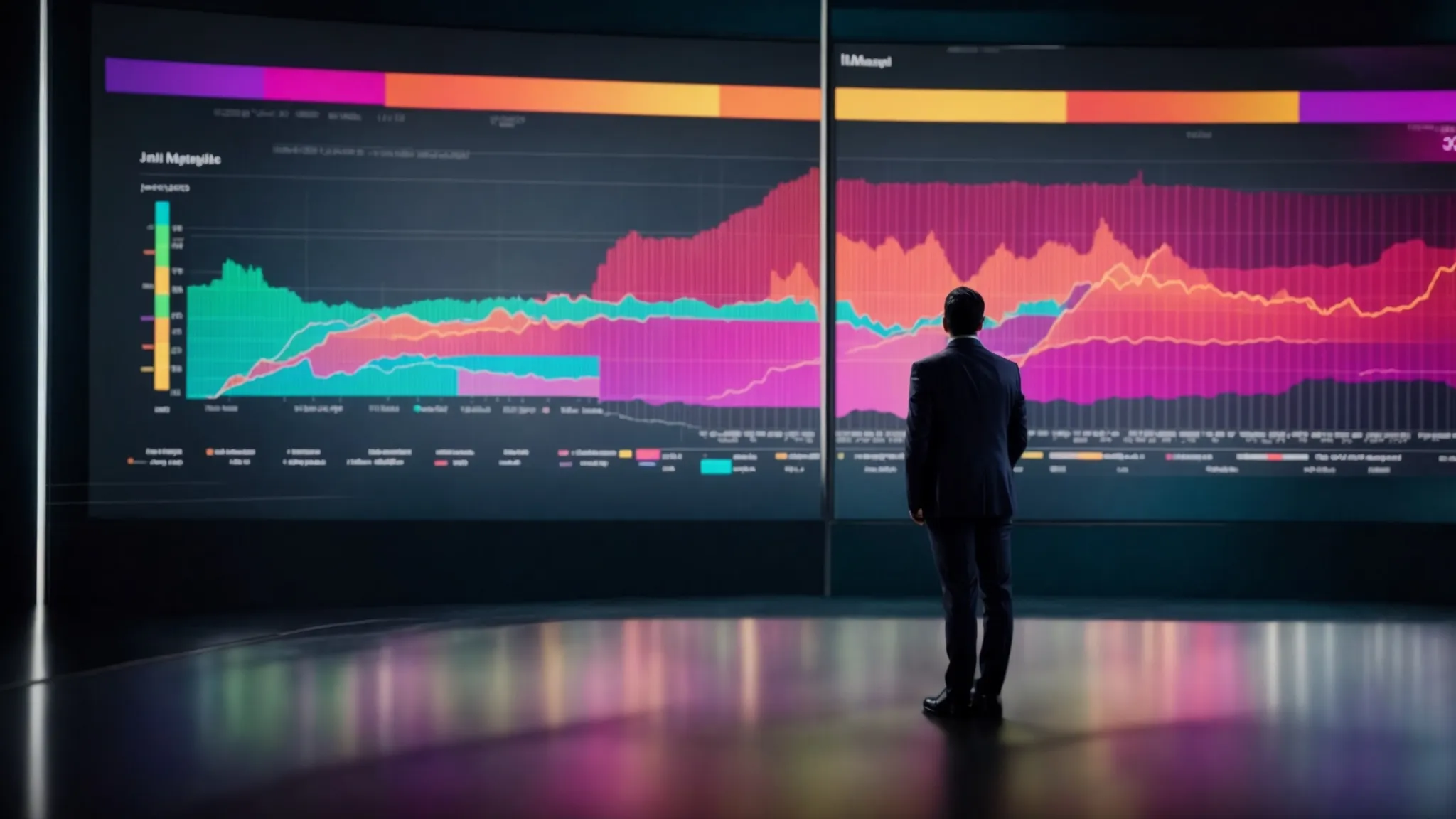
What Is Audience Analysis: A Comprehensive Guide
In the labyrinth of digital marketing, understanding your audience resembles finding a compass in the vast sea of online content.
Audience analysis, a beacon of insight, illuminates the path to crafting messages that resonate deeply with your intended listeners or readers.
It’s not merely a task; it’s an art form that blends demographics, psychology, and strategy into a coherent map for engagement.
With it, you can tailor your content, tone, and message to the beating heart of your audience’s needs and expectations.
Keep reading as we delve into the nuances of audience analysis, unlocking secrets to elevate your connection with your audience to unprecedented heights.
Key Takeaways
- Audience Analysis Is an Essential Foundation for Creating Content That Truly Resonates With the Intended Demographic
- By Delving Into Both Demographic Analysis and Psychographic Profiling, Marketers Can Craft Strategies That Foster Deep and Meaningful Connections
- Surveys and Analytics Tools Are Pivotal in Gathering and Interpreting the Nuanced Desires and Behaviors of the Audience
- Adjusting Content and Communication Channels According to Audience Preferences Ensures Higher Engagement and Impact
- Navigating the Evolving Landscape of Audience Analysis Requires Agility, Continuous Adaptation, and a Thorough Understanding of Data Integration Challenges
Understanding the Basics of Audience Analysis

At the heart of every successful digital marketing endeavor, from the bustling streets of Bangladesh to the expansive avenues of the internet at large, lies the cornerstone of audience analysis.
This intricate process serves as the compass for steering campaigns in the right direction, ensuring messages resonate with the intended ears.
Demystifying audience analysis involves peeling back the layers to reveal who your audience truly is, beyond mere numbers or statistics.
It’s about delving into the fabric of your audience’s lives—understanding their pains, pleasures, desires, and deterrence.
With this knowledge in hand, crafting content that speaks directly to their hearts becomes less of an art and more of a science.
Freelancer Tamal, nestled in the vibrant heart of Bangladesh’s digital marketing scene, embodies this philosophy, turning audience insights into actionable strategies that captivate and convert.
Hence, grasping the essence of audience analysis is not just about marking checkboxes; it’s about illuminating the path to meaningful connections and, ultimately, unmatched successes.
Defining Audience Analysis in Simple Terms
At its core, audience analysis unfolds the mysteries of who is on the receiving end of your digital communications: It investigates the tapestry of demographics, attitudes, expectations, and behaviors that define a group of individuals. This exploration into the audience’s psyche aims to tailor messages that resonate on a personal and impactful level.
By unraveling the elements that make your audience unique, audience analysis becomes a critical tool. It shifts from a mere task to a strategic foundation, enabling the creation of content that not only reaches but also speaks to the heart of each individual in your audience:
- Demographic analysis of an audience paints a picture of age, gender, education, and more, offering a macro view of who they are.
- Audience assessment delves deeper, seeking to understand the audience’s attitudes, beliefs, and values—elements that drive decision-making.
- Situational audience analysis refers to identifying the specific circumstances and contexts in which your audience interacts with your content, providing insights into when and how to reach them effectively.
Why Knowing Your Audience Is Key to Success
Identifying the pulse of your audience’s desires and demands is akin to navigating the unpredictable currents of digital marketing with a precise compass: it’s indispensable. By painting a vivid picture of who your audience is, what they stand for, and how they perceive the world around them, Freelancer Tamal crafts campaigns that resonate on an almost cellular level. This nuanced understanding not only paves the way for engagement but also forges lasting connections that transcend the superficial layers of mere transactions.
Detecting the shifting sands of audience preferences and expectations allows for the agile adjustment of strategies, ensuring that messages hit their mark with the accuracy of an archer. In an online landscape where attention spans are fleeting and competition fierce, the ability to entwine your strategy with the very thread of your audience’s lifeblood can mean the difference between obscurity and prominence:
- By unravelling the complex tapestry of your audience’s demographic, you uncover the primary colors of their identity.
- Delving deep into their beliefs and values, you sketch the outlines of content that mirrors their innermost thoughts.
- Understanding the situational contexts in which they seek out content allows you to tailor your narratives, making them timely and relevant.
Now that we’ve laid the foundation with the essentials of audience analysis, buckle up! We’re about to explore the vibrant landscape of its major types, each a unique key to unlocking profound connections.
The Major Types of Audience Analysis Explained

Peering into the heart of your audience, understanding their core, necessitates a dive into two pivotal types of audience analysis: Demographic Analysis and Psychographic Profiling.
The former lays the foundation, illustrating a clear picture through age, gender, education, and other quantifiable measures.
It’s akin to sketching the outline of a portrait, delineating the basic shapes that form an audience’s identity.
Conversely, Psychographic Profiling colors inside these lines, bringing the sketch to life by delving into preferences, lifestyles, and values.
This comprehensive approach ensures messages not only reach but also deeply resonate with the audience, forging connections that transcend mere awareness to foster genuine loyalty.
Demographic Analysis for a Clearer Picture
Demographic analysis serves as the scaffolding upon which deeper audience insights are constructed. It offers a rudimentary snapshot by charting the age, gender, location, and educational background of an audience: essential variables that paint the first strokes of understanding.
- Age distribution leads to tailoring content that meets generational preferences and expectations.
- Gender analysis guides the tone and topics, ensuring relevance across the spectrum of audience demographics.
- Educational background offers clues about the audience’s complexity of language and subject matter they would find engaging.
This method of audience analysis highlights the importance of recognizing the surface-level characteristics that define a group. Through these lenses, marketers can begin to sculpt communication strategies that resonate more broadly before diving into the nuanced depths of psychographic profiling.
Psychographic Profiling to Understand Preferences
Psychographic profiling dives into the intricate patterns of an audience’s lifestyle, interests, and opinions, unearthing a rich tapestry of insights that demographic analysis alone cannot reveal. This approach delves beyond the surface, seeking to understand the driving forces behind consumer behavior—what makes them tick, what fuels their desires, and how they view the world around them. Through this lens, messages are not just seen and heard but felt, creating a resonance that echoes through the chambers of their values and beliefs.
In the realm of psychographic profiling, preferences become the guiding stars that illuminate the path to truly impactful communication. It crafts narratives that wrap around the audience’s deepest convictions, knitting together their aspirations with the marketer’s message. By harnessing this level of understanding, Freelancer Tamal and others in his field can deliver content that not only garners attention but fosters an enduring connection, transforming passive observers into passionate advocates.
Understanding the major types of audience analysis lights the path forward. Let’s unlock the secrets to conducting effective audience analysis with precision and flair.
Steps to Conduct Effective Audience Analysis

Embarking on the journey of audience analysis requires a meticulous approach, beginning with the precise identification of your target audience.
This initial step is akin to setting the sails for a voyage across the vast ocean of digital marketing, where understanding the nuances of the demographic and psychographic landscape is paramount.
Following this, the gathering and analyzing of data about your audience acts as the compass that guides the direction of your content strategy.
It is through this systematic collection of insights and information—spanning from behaviors to preferences—that a comprehensive picture emerges, paving the way for crafting messages that resonate profoundly with those you seek to reach.
Identifying Your Target Audience Accurately
Identifying your target audience accurately is akin to a painter selecting the perfect palette before the brush even touches the canvas. It requires a deep dive into the sea of your market, distinguishing between various swaths of potential listeners to pinpoint those whose interests align most closely with your messages.
This precision in identification is the bedrock upon which all subsequent audience analysis steps are built. By understanding not just the broad demographics that define a group but peeling back layers to reveal the nuanced interests and behaviors, marketers carve out the fertile ground from which tailored, resonant campaigns can grow.
Gathering and Analyzing Data About Your Audience
Gathering data about your audience is akin to a miner sifting through the earth, searching for those precious nuggets of insight that will illuminate the path forward. This step involves collecting a diverse range of information from various sources – social media analytics, surveys, website interaction data, and even direct feedback, forming a mosaic of understanding about who your audience truly is and what they seek.
Analyzing this data is where the magic happens, transforming raw information into a strategic roadmap. The process demands a keen eye for patterns and anomalies within the data, deciphering the silent whispers of your audience’s needs and preferences. It is here that Freelancer Tamal, with his adept mastery of digital alchemy, turns mere data into gold, crafting strategies that resonate deeply and personally with the intended recipients.
Unveiling the steps to conduct effective audience analysis sets the stage. Let’s journey further, exploring the arsenal of tools and methods to gather those invaluable audience insights.
Tools and Methods for Gathering Audience Insights

In the quest to unveil the intricacies of one’s audience, marketers have at their disposal a toolbox brimming with methods and instruments, each designed to probe different facets of audience understanding.
Among these, surveys and questionnaires shine as beacons of direct insight, inviting the audience to voice their preferences and experiences explicitly.
On the contrasting side of the spectrum, leveraging analytics stands as a silent observer, gleaning indirect observations from digital footprints left behind by audience interactions.
These complementary approaches serve as the twin pillars upon which a robust audience analysis framework is constructed, offering a multi-dimensional exploration of the audience psyche.
Surveys and Questionnaires for Direct Feedback
Surveys and questionnaires act as bridges over the gap between marketers and their audiences, enabling a direct line of communication for feedback. This method allows Freelancer Tamal and his peers to gather candid insights from their voluntary audience, thus providing a clearer, unfiltered view of their preferences, experiences, and expectations. It’s a proactive approach that puts a spotlight on the audience’s voice, making them active participants in shaping marketing strategies.
In the hands of an adept digital marketer like Freelancer Tamal, surveys and questionnaires transform into potent tools for sculpting audience-centric campaigns. They not only reveal the demographic breakdown of an audience but also expose the nuanced textures of their attitudes and beliefs. Consequently, this direct feedback mechanism empowers marketers to refine their strategies, ensuring each campaign resonates deeply and effectively with its intended public.
Leveraging Analytics for Indirect Observations
In the domain of audience insight gathering, leveraging analytics stands as a silent sentinel, diligently observing the digital trail an audience leaves behind. This indirect observation method acts as a non-intrusive eye, delicately piecing together a comprehensive understanding of audience behaviors and interactions from afar.
Analytics tools, through their meticulous collection and analysis of data, offer a panoramic view of user engagement, content preferences, and pathways through which the audience navigates digital platforms. By decoding these digital breadcrumbs, marketers like Freelancer Tamal gain invaluable insights, crucial for sculpting messages that echo the audience’s unspoken needs and desires:
| Tool | Insight Gained | Application |
|---|---|---|
| Website Analytics | User Engagement Patterns | Content Optimization |
| Social Media Monitoring | Content Preferences | Strategy Tailoring |
| Email Campaign Analysis | Response Rates | Message Personalization |
Armed with the tools and methods detailed earlier, we stand at the threshold of transformation. Let’s channel these insights into strategies that skyrocket engagement.
Applying Your Findings to Boost Engagement

Translating the rich tapestry of audience analysis into actionable strategies for heightened engagement demands a nuanced approach, one that Freelancer Tamal has seamlessly integrated into his digital marketing expertise.
At the crossroads where data meet decision-making, the ability to mold your content and choose the most receptive channels lays the groundwork for fostering deeper connections.
This pivotal phase goes beyond mere acknowledgment of audience characteristics, venturing into the strategic adaptation of content and communication mediums to align with both expressed and latent audience expectations.
It is here that the art of audience analysis transcends its analytical roots, morphing into the very essence of dynamic and responsive digital marketing strategies.
Tailoring Content to Match Audience Expectations
In the mosaic of digital marketing, tailoring content to match audience expectations is akin to finding the perfect key for a lock. This precise alignment between what audiences seek and the content presented to them is the cornerstone of engagement, acting as the conduit through which messages not only reach their destination but also spark action and interaction.
| Aspect | Insight | Application |
|---|---|---|
| Content Tone | Audience’s Emotional Tone Preference | Adjusting Message Tone |
| Content Format | Preferred Media Types | Selection of Visual, Textual, or Video Content |
| Engagement Time | Peak Audience Online Times | Scheduling Content Release |
By weaving into content the diverse threads of insights garnered from nuanced analysis—ranging from emotional tone to preferred media formats—marketers, epitomized by Freelancer Tamal, craft narratives that resonate on a profound level. This approach solidifies the bridge between content creators and their audience, ensuring that every piece of communication is not only seen but also felt, echoing through the corridors of the audience’s expectations with precision and empathy.
Adjusting Communication Channels as Needed
In the intricate dance of digital marketing, adjusting communication channels as required is akin to changing rhythms smoothly in a melody: It ensures the message not only resonates but is also delivered through the most harmonious medium. This necessitates a keen understanding of where the audience spends their time and how they prefer to consume content: A dynamic landscape that shifts with trends and technological advancements.
For marketers like Freelancer Tamal, the agility to pivot across platforms — from the bustling forums of social media to the more intimate setting of email inboxes — is testament to the depth of audience analysis executed. It’s about matching the mode of delivery to the audience’s lifestyle and preferences, ensuring that every interaction is both timely and engaging:
| Channel | Audience Preference | Strategy Adjustment |
|---|---|---|
| Social Media | High Engagement Visual Content | Increasing Multimedia Posts |
| Personalized Communication | Customized Email Campaigns | |
| Website | Easy Navigation & Information Accessibility | Improving User Experience |
By strategically deploying content across the most receptive channels, Freelancer Tamal ensures that every piece of communication is optimized for maximum impact. It’s a testament to the philosophy that knowing where your audience is just as crucial as knowing who they are.
The journey through the maze of audience engagement has equipped us with key insights. But let us not forget, deciphering your audience’s core isn’t without its hurdles.
Challenges in Accurate Audience Analysis

Navigating the intricate maze of audience analysis presents a unique set of challenges that marketers and digital professionals like Freelancer Tamal face. Despite the wealth of available data, distilling this into actionable insights remains a daunting task: a testament to the complexity of human behavior and preferences.
- Ever-evolving trends and technologies introduce a layer of unpredictability, making it hard to maintain an up-to-date understanding of audience preferences.
- Data silos and integration issues often hinder a holistic view of the audience, leading to fragmented insights that may not represent the full picture.
- The subjective nature of interpreting qualitative data can introduce biases, potentially skewing the strategy based on incomplete or inaccurate analysis.
- Privacy regulations and ethical considerations limit the depth of insights that can be gathered, imposing boundaries on how intimately marketers can understand their audience.
The pace at which digital landscapes transform is nothing short of meteoric, posing a challenge for marketers aiming to stay abreast of the latest audience trends. This constant flux demands agility and a continuous loop of analysis and adaptation to remain relevant and resonant.
Moreover, integrating disparate data sources to form a cohesive understanding of the audience is akin to assembling a complex puzzle without a guiding picture. Marketers must navigate through the noise to piece together meaningful insights from various channels and platforms.
In this high-stakes game of digital strategy, the ability to accurately interpret and act on audience analysis becomes the dividing line between messaging that fades into the background and campaigns that truly engage and captivate. The hurdles are numerous, but with meticulous strategy and adaptability, success lies within reach for those willing to dive deep into the intricacies of audience analysis.
Conclusion
Audience analysis stands as the pivotal foundation of successful digital marketing strategies, offering a nuanced understanding of who an audience truly is—beyond basic demographics to their beliefs, preferences, and situational contexts.
By employing both demographic analysis and psychographic profiling, marketers can tailor messages that resonate deeply, fostering meaningful connections and loyalty.
Freelancer Tamal exemplifies this approach by translating intricate audience insights into actionable strategies that captivate and convert.
Effective audience analysis involves a meticulous process of identifying the target audience, gathering and analyzing data through surveys, questionnaires, and analytics, and applying these findings to tailor content and communication channels accordingly.
Despite the challenges of ever-evolving trends, data integration issues, and privacy concerns, a robust audience analysis enables marketers to craft engaging messages and adjust strategies to meet the dynamic needs of their audience.
Audience analysis, therefore, is not just a cornerstone of digital marketing; it’s the strategic compass guiding campaigns to unparalleled success in the ever-competitive online landscape.
- digital marketing for small businessesby Freelancertamal●February 13, 2024
- Unlocking Success: My Proven Rangpur Digital Marketing Strategyby Freelancertamal●January 4, 2024
- Elevate Your Business: Rangpur Internet Marketing Strategies That Workby Freelancertamal●January 4, 2024
- এসইও ক্যারিয়ারby Freelancertamal●February 14, 2024










